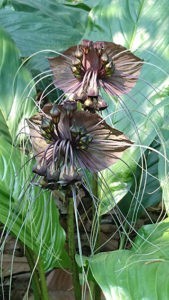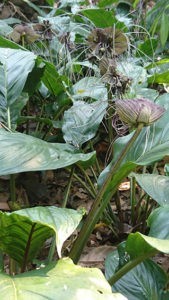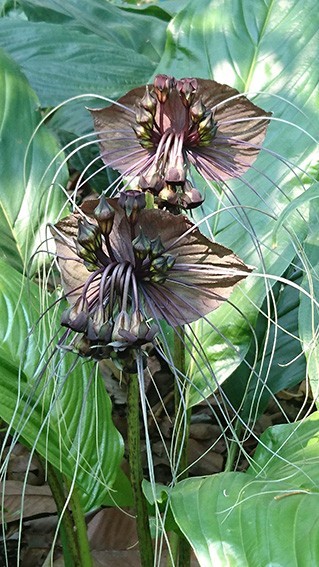Scientific name: Tacca chantrieri
English common name: Black Bat Flower or Devil Flower
Lao name: Phon men
Plant family : Dioscoreaceae (Yam family)
Tiger’s moustache (“Moustaches de tigre”, the French name), Black bat flower – the names for this plant are very imaginative in multiple languages, no doubt due to their amazing beauty, mesmerizing colour and strange appearance.
The Tacca genus, which belongs to the Yam family, gets its name from the Indonesian word, “taka”, which is the Indonesian name for these plants. The two genera and thirteen species in this plant family come almost exclusively from Asia.
They look similar to the yams with which they are often confused, and they are perennials with tuberous roots. They have large, elongated, simple leaves, sometimes lobed, growing directly from the tuber. The flowers are grouped in umbels at the end of long stalks, also attached directly to the tuber. The most spectacular part of the plant is undoubtedly the large bracts extending like wings around the flowers. Next to these there are long filaments (bracteoles) which give the inflorescence the appearence of feline whiskers. The actual flowers are clustered in the middle of all of this and are the most unassuming part of the whole thing!

Black bat flowers in the Limestone Habitat at PTK
Numerous species of Tacca can be found in Laos, the most spectacular of which, the Tacca chantrieri, is cultivated extensively as a decorative plant, but is also found growing wild in the humid areas of northern Laos and in Khammouane province. The black bat flower has been extensively exploited for horticultural use, with so many plants being collected from the wild that, in China, the plant is a protected species.
As beautiful as the flower is, one can also use the tuber as food or medication. The Hmong people consume this root after having macerated it for a long period to eliminate its bitterness. In Vietnam, in all seasons, the harvested rhizomes are washed, cut into fine strips, put in the sun to dry, or steamed, and then put to macerate in alcohol. This preparation is used in massage in the case of rheumatic fever.
“Phon men“ is the name the Lao give to Tacca chantrieri but also to the similar species Tacca integrifolia. This flower, equally as complex as that of the black bat flower, is, however, less spectacular because its « wings » are smaller and a greenish or white colour.
In the north, the young leaves of both species are grilled or eaten raw with an accompanying piquant sauce. They have a pleasant bitterness and are strengthening when consumed.
In the past, the tubers, rich in starch, were fermented to make alcohol. Today, the Traditional Medicine Research Center has registered this plant for its phytotherapy properties. In Akha villages, the decoction of the rhizome is prescribed as an aphrodisiac and in cases of anemia.
Text by Dr Biba Vilaylek, PTK Ethnobotanist. Translation from French kindly done by Gillian Marshall. Edits and photographs by Bryony Smart,
PTK Botanist.




